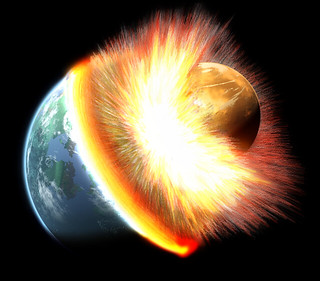The
accepted theory since the 1980s is that the Moon arose as a result of a
collision between the Earth and Theia 4.5bn years ago.
Earlier analyses had shown Moon rock to have originated entirely from the Earth whereas computer simulations had shown that the Moon ought to have been mostly derived from Theia
According to the lead researcher, Dr Daniel Herwartz, from the University of Goettingen, no one has found definitive evidence for the collision theory, until now. "It was getting to the stage where some people were suggesting that the collision had not taken place," he told BBC News.
But the difference, some say, could be explained by material absorbed by the Earth after the Moon formed. And Prof Alex Halliday of Oxford University, is among many scientists who are surprised at the difference between the Theian material found in the Moon rock and the Earth is so small. "What you are looking for is a much bigger difference, because that is what the rest of the Solar System looks like based on meteorite measurements," he said.
Dr Herwartz
measured the difference in what is called the isotopic composition of
the oxygen contained in rocks on Earth and Moon rock. This is the ratio
of different forms of oxygen.
If that is the case then all the arguments over the similarities of the Earth and the Moon fall away," he told BBC News. Dr Dr Mahesh Anand from The Open University described the research as "exciting" but noted that the data was from just three lunar rock samples. "We have to be cautious about representativeness of these rocks of the entire Moon, and so further analysis of a variety of lunar rocks is required for further confirmation," he said. Other theories have been proposed to explain why the composition of the Earth and Moon are so similar: one is that the Earth spun much faster before impact, another is that Theia was much larger than current models suggest. An alternative, controversial, theory proposed by Prof Rob de Meijer of Groningen University in the Netherlands was that the Earth's crust and mantle was blown into space by an accumulation of nuclear material 2,900km below the surface. It was this debris that clumped together to form the Moon. He told BBC News that the new finding - demonstrating that there was a difference in the composition of the Earth and the Moon - did not change his view. "The difference is too small," he said. "We don't know how the Moon was formed.
What we need are manned missions to the Moon and a search for rocks deeper under the lunar surface, that have not been polluted by meteorite impacts and the solar wind."
Traces of another world found on the Moon | BBC
Earlier analyses had shown Moon rock to have originated entirely from the Earth whereas computer simulations had shown that the Moon ought to have been mostly derived from Theia
According to the lead researcher, Dr Daniel Herwartz, from the University of Goettingen, no one has found definitive evidence for the collision theory, until now. "It was getting to the stage where some people were suggesting that the collision had not taken place," he told BBC News.
But the difference, some say, could be explained by material absorbed by the Earth after the Moon formed. And Prof Alex Halliday of Oxford University, is among many scientists who are surprised at the difference between the Theian material found in the Moon rock and the Earth is so small. "What you are looking for is a much bigger difference, because that is what the rest of the Solar System looks like based on meteorite measurements," he said.
 |
| pseud_great (Photo credit: Rufus Gefangenen) |
If that is the case then all the arguments over the similarities of the Earth and the Moon fall away," he told BBC News. Dr Dr Mahesh Anand from The Open University described the research as "exciting" but noted that the data was from just three lunar rock samples. "We have to be cautious about representativeness of these rocks of the entire Moon, and so further analysis of a variety of lunar rocks is required for further confirmation," he said. Other theories have been proposed to explain why the composition of the Earth and Moon are so similar: one is that the Earth spun much faster before impact, another is that Theia was much larger than current models suggest. An alternative, controversial, theory proposed by Prof Rob de Meijer of Groningen University in the Netherlands was that the Earth's crust and mantle was blown into space by an accumulation of nuclear material 2,900km below the surface. It was this debris that clumped together to form the Moon. He told BBC News that the new finding - demonstrating that there was a difference in the composition of the Earth and the Moon - did not change his view. "The difference is too small," he said. "We don't know how the Moon was formed.
What we need are manned missions to the Moon and a search for rocks deeper under the lunar surface, that have not been polluted by meteorite impacts and the solar wind."
Traces of another world found on the Moon | BBC





No comments:
Post a Comment